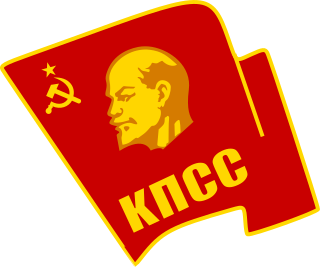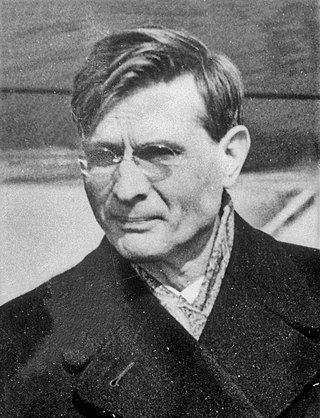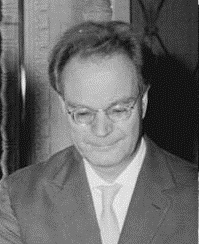History
Before the October Revolution, the job of the party secretary was largely that of a bureaucrat. Following the Bolshevik seizure of power, the Office of the Responsible Secretary was established in 1919 to perform administrative work. After the Bolshevik victory in the Russian Civil War, the Office of General Secretary was created by Vladimir Lenin in 1922 with the intention that it serve a purely administrative and disciplinary purpose. Its primary task would be to determine the composition of party membership and to assign positions within the party. The General Secretary also oversaw the recording of party events, and was entrusted with keeping party leaders and members informed about party activities.
When assembling his cabinet, Lenin appointed Joseph Stalin to be General Secretary. Over the next few years, Stalin was able to use the principles of democratic centralism to transform his office into that of party leader, and eventually leader of the Soviet Union. Trotsky attributed his appointment to the initial recommendation of Grigory Zinoviev. [9] This view has been supported by several historians. [10] [11] According to Russian historian, Vadim Rogovin, Stalin's election to the position occurred after the Eleventh Party Congress (March–April 1922), in which Lenin, due to his poor health, participated only sporadically, and only attended four of the twelve sessions of the Congress. [12]
Some historians have regarded the premature death of prominent Bolshevik Yakov Sverdlov to have been a key factor in facilitating the elevation of Joseph Stalin to the position of leadership in the Soviet Union. In part, because Sverdlov served as the original chairman of the party secretariat and was considered a natural candidate for the position of General Secretary. [13] [14]
Prior to Lenin's death in 1924, Stalin's tenure as General Secretary was already being criticized. [15] In Lenin's final months, he authored a pamphlet that called for Stalin's removal on the grounds that Stalin was becoming authoritarian and abusing his power. The pamphlet triggered a political crisis which endangered Stalin's position as General Secretary, and a vote was held to remove him from office. With the help of Grigory Zinoviev and Lev Kamenev, Stalin was able to survive the scandal and remained in his post. After Lenin's death, Stalin began to consolidate his power by using the office of General Secretary. By 1928, he had unquestionably become the de facto leader of the USSR, while the position of General Secretary became the highest office in the nation. In 1934, the 17th Party Congress refrained from formally re-electing Stalin as General Secretary. However, Stalin was re-elected to all the other positions he held, and remained leader of the party without diminution. [16]
In the 1950s, Stalin increasingly withdrew from Secretariat business, leaving the supervision of the body to Georgy Malenkov, possibly to test his abilities as a potential successor. In October 1952, at the 19th Party Congress, Stalin restructured the party's leadership. His request, voiced through Malenkov, to be relieved of his duties in the party secretariat due to his age, was rejected by the party congress, as delegates were unsure about Stalin's intentions. In the end, the congress formally abolished Stalin's office of General Secretary, although Stalin remained one of the party secretaries and maintained ultimate control of the party. [19] When Stalin died on 5 March 1953, Malenkov was considered to be the most important member of the Secretariat, which also included Nikita Khrushchev, among others. Under a short-lived troika consisting of Malenkov, Beria, and Molotov, Malenkov became Chairman of the Council of Ministers, but was forced to resign from the Secretariat nine days later on 14 March. This effectively left Khrushchev in control of the government, and he was elected to the new office of First Secretary of the Communist Party of the Soviet Union at the Central Committee plenum on 14 September that same year. Khrushchev subsequently outmanoeuvred his rivals, who sought to challenge his political reforms. He was able to comprehensively remove Malenkov, Molotov and Lazar Kaganovich (one of Stalin's oldest and closest associates) from power in 1957, an achievement which also helped to reinforce the supremacy of the position of First Secretary.
In 1964, opposition within the Politburo and the Central Committee, which had been increasing since the aftermath of the Cuban Missile Crisis, led to Khrushchev's removal from office. Leonid Brezhnev succeeded Khrushchev as First Secretary, but was initially obliged to govern as part of a collective leadership, forming another troika with Premier Alexei Kosygin and Chairman Nikolai Podgorny. The office was renamed to General Secretary in 1966. The collective leadership was able to limit the powers of the General Secretary during the Brezhnev Era. Brezhnev's influence grew throughout the 1970s as he was able to retain support by avoiding any radical reforms. After Brezhnev's death, Yuri Andropov and Konstantin Chernenko were able to rule the country in the same way as Brezhnev had. Mikhail Gorbachev ruled the Soviet Union as General Secretary until 1990, when the Communist Party lost its monopoly of power over the political system. The office of President of the Soviet Union was established so that Gorbachev could still retain his role as leader of the Soviet Union. Following the failed August coup of 1991, Gorbachev resigned as General Secretary. He was succeeded by his deputy, Vladimir Ivashko, who only served for five days as Acting General Secretary before Boris Yeltsin, the newly elected President of Russia, suspended all activity in the Communist Party. Following the party's ban, the Union of Communist Parties – Communist Party of the Soviet Union (UCP–CPSU) was established by Oleg Shenin in 1993, and is dedicated to reviving and restoring the CPSU. The organisation has members in all the former Soviet republics.

The Communist Party of the Soviet Union (CPSU), at some points known as the Russian Communist Party, All-Union Communist Party and Bolshevik Party, and sometimes referred to as the Soviet Communist Party (SCP), was the founding and ruling political party of the Soviet Union. The CPSU was the sole governing party of the Soviet Union until 1990 when the Congress of People's Deputies modified Article 6 of the 1977 Soviet Constitution, which had previously granted the CPSU a monopoly over the political system. The party's main ideology was Marxism–Leninism.

Leonid Ilyich Brezhnev was a Soviet politician who served as General Secretary of the Communist Party of the Soviet Union from 1964 until his death in 1982, and Chairman of the Presidium of the Supreme Soviet from 1960 to 1964 and again from 1977 to 1982. His 18-year term as General Secretary was second only to Joseph Stalin's in duration. To this day, the quality of Brezhnev's tenure as General Secretary remains debated by historians.

Mikhail Andreyevich Suslov was a Soviet statesman during the Cold War. He served as Second Secretary of the Communist Party of the Soviet Union from 1965, and as unofficial chief ideologue of the party until his death in 1982. Suslov was responsible for party democracy and power separation within the Communist Party. His hardline attitude resisting change made him one of the foremost orthodox communist Soviet leaders.

The Secretariat of the Central Committee of the Communist Party of the Soviet Union (CPSU) was responsible for managing and directing the day-to-day operations of the Communist Party of the Soviet Union, while the Politburo was charged with the policy-making aspects of the party. The Secretariat was a component agency of the party's Central Committee.

Alexei Nikolayevich Kosygin was a Soviet statesman during the Cold War. He served as the Premier of the Soviet Union from 1964 to 1980 and was one of the most influential Soviet policymakers in the mid-1960s along with General Secretary Leonid Brezhnev.
The history of the Communist Party of the Soviet Union was generally perceived as covering that of the Bolshevik faction of the Russian Social Democratic Labour Party from which it evolved. In 1912, the party formally split, and the predecessor to the Communist Party of the Soviet Union became a distinct entity. Its history since then can roughly be divided into the following periods:

Andrey Andreyevich Andreyev was a Soviet Communist politician. An Old Bolshevik who rose to power during the rule of Joseph Stalin, joining the Politburo as a candidate member in 1926 and as a full member in 1932, Andreyev also headed the powerful Central Control Commission of the Communist Party of the Soviet Union from 1930 to 1931, and then again from 1939 until 1952.

Pyotr Nikolayevich Pospelov was a high-ranked functionary of the Communist Party of the Soviet Union, propagandist, academician of the USSR Academy of Sciences (1953), chief editor of Pravda newspaper, and director of the Institute of Marxism-Leninism. He was known as a staunch Stalinist who quickly became a supporter of Nikita Khrushchev.

The Presidium of the 22nd Congress of the Communist Party of the Soviet Union (CPSU) was in session from 1961 to 1966. CPSU First Secretary Nikita Khrushchev chaired the Presidium from 1961 to 1964; Leonid Brezhnev succeeded him that year and chaired it until 1966. In contrast to full members, candidate members of the Presidium could not vote during Presidium sessions. It was normal that a full member of the Presidium had previously served as a candidate member, but this was not always the case. During the term 23 people held seats in the Presidium: 14 full members and 9 candidate members. One candidate member was promoted to full membership in the Presidium during the term. Not a single Presidium member died during this period while retaining office.

Mikhail Georgiyevich Pervukhin was a Soviet official during the Stalin Era and Khrushchev Era. He served as a First Deputy Chairman of the Council of Ministers, literally First Vice-Premier of the Soviet Union, from 1955 to 1957.

The history of Soviet Russia and the Soviet Union (USSR) reflects a period of change for both Russia and the world. Though the terms "Soviet Russia" and "Soviet Union" often are synonymous in everyday speech, when referring to the foundations of the Soviet Union, "Soviet Russia" often specifically refers to brief period between the October Revolution of 1917 and the creation of the Soviet Union in 1922.

Georgy Maximilianovich Malenkov was a Soviet politician who briefly succeeded Joseph Stalin as leader of the Soviet Union after his death in March 1953. After one week, Malenkov was forced to give up control of the party apparatus, but continued to serve as premier. He then entered a power struggle with party leader Nikita Khrushchev, who surpassed Malenkov in the country's leadership by late 1953 before securing Malenkov's removal as premier in 1955.

Collective leadership, or collectivity of leadership, was considered the ideal form of governance in the Union of Soviet Socialist Republics (USSR) and other socialist states espousing communism. Its main task was to distribute powers and functions among the Politburo and the Central Committee of the Communist Party of the Soviet Union, as well as the Council of Ministers, to hinder any attempts to create a one-man dominance over the Soviet political system by a Soviet leader, such as that seen under Joseph Stalin's rule. On the national level, the heart of the collective leadership was officially the Central Committee of the Communist Party. Collective leadership was characterised by limiting the powers of the General Secretary and the Chairman of the Council of Ministers as related to other offices by enhancing the powers of collective bodies, such as the Politburo.
On the Cult of Personality and Its Consequences, popularly known as the Secret Speech, was a report by Soviet leader Nikita Khrushchev, First Secretary of the Communist Party of the Soviet Union, made to the 20th Congress of the Communist Party of the Soviet Union on 25 February 1956. Khrushchev's speech was sharply critical of the rule of the deceased General Secretary and Premier Joseph Stalin, particularly with respect to the purges which had especially marked the last years of the 1930s. Khrushchev charged Stalin with having fostered a leadership cult of personality despite ostensibly maintaining support for the ideals of communism. The speech was leaked to the West by the Israeli intelligence agency Shin Bet, which received it from the Polish-Jewish journalist Wiktor Grajewski.

The Central Committee of the Communist Party of the Soviet Union was the highest organ of the Communist Party of the Soviet Union between two congresses. According to party statutes, the committee directed all party and governmental activities. The Party Congress elected its members.
De-Stalinization comprised a series of political reforms in the Soviet Union after the death of long-time leader Joseph Stalin in 1953, and the thaw brought about by ascension of Nikita Khrushchev to power, and his 1956 secret speech "On the Cult of Personality and Its Consequences", which denounced Stalin's cult of personality and the Stalinist political system.
The Nineteenth Congress of the Communist Party of the Soviet Union was held from 5 to 14 October 1952. It was the first party congress after World War II and the last under Joseph Stalin's leadership. It was attended by many dignitaries from foreign Communist parties, including Liu Shaoqi from China. At this Congress, Stalin gave the last public speech of his life. The 19th Central Committee was elected at the congress.
The Central Committee (CC) composition was elected by the 16th Congress, and sat from 13 July 1930 until 10 February 1934. Its 1st Plenary Session elected the Politburo, Secretariat and Orgburo. The 16th Congress was the first party convention since the 13th Congress which saw no organized opposition, and the first congress in party history in which there was no opposition to the party leadership. Ukrainian historian Oleg Khlevniuk considers the period 1930–1934 to be a "transitional period" between collective leadership (referred to interchangeably by him as oligarchy) and Joseph Stalin's personal dictatorship (autocracy). The removal of Alexei Rykov, the Chairman of the Council of People's Commissars (SNK, the Soviet government), from the Politburo at the 1st Joint Plenary Session of the CC and the Central Control Commission (CCC) has been marked in historic literature as "the definitive Stalinization of that body [Politburo]" according to Khlevniuk.

The Central Committee of the 17th Congress of the All-Union Communist Party (Bolsheviks) sat from 10 February 1934 until the convening of the 18th Congress on 10 March 1939. Its 1st Plenary Session elected the Politburo, Secretariat and Orgburo. The 17th Congress was labelled the "Congress of Victors" to mark the success of the first five-year plan and the collectivization of agriculture. The CC 1st Plenary Session elected Joseph Stalin General Secretary of the Central Committee, and Lazar Kaganovich continued to serve as Stalin's deputy, an informal post referred to by Sovietologists as Second Secretary, and was empowered to manage party business and sign Politburo resolutions when Stalin was away from Moscow.

























